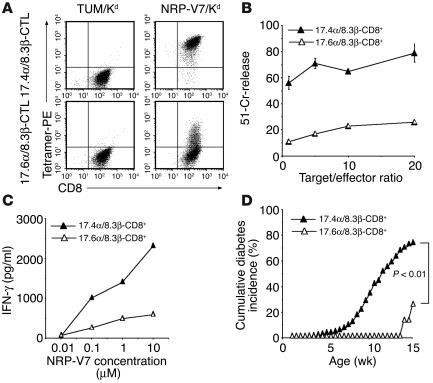Figure 3.
Avidity and diabetogenic potential of peripheral IGRP206–214 tetramer+ cells from 17.6α/8.3β-Tg versus 17.4α/8.3β-Tg animals. (A) Tetramer-binding ability of 17.6α/8.3β versus 17.4α/8.3β CTL lines (generated by stimulation of naive splenic CD8+ cells with NRP-V7 in the presence of rIL-2). (B) Cytolytic activity of in vitro–differentiated CTL lines against NRP-V7 peptide-pulsed RMA-S/Kd targets (percentages of 51-Cr release against targets pulsed with the negative control peptide TUM were subtracted). Since Tg CD8+ T cells from both types of mice do not expand (or survive) when stimulated with irrelevant peptides, these assays reflect differences in cytolytic activity between CD8+ cells of identical antigenic specificity but different avidity. (C) Secretion of IFN-γ by purified CD8+ splenocytes (adjusted for the number of IGRP206–214 tetramer–positive cells) to various concentrations of NRP-V7 (donor mice were > 6 weeks old). (D) Cumulative incidence of diabetes in 8 (17.6α/8.3β-Tg) versus 214 (17.4α/8.3β-Tg) female mice for the period of time the former were followed.

